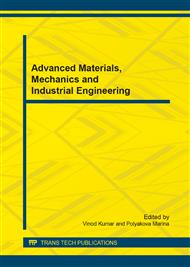p.51
p.55
p.60
p.66
p.73
p.78
p.82
p.86
p.90
Experimental Investigations to Evaluate the Mechanical Properties and Behavior of Raw and Alkali Treated King’s Crown (Calotropis Gigantea) Fiber to be Employed for Fabricating Fiber Composite
Abstract:
A fiber extracted from King’s crown plant belonging to apoceynaceal family is a budding component identified for potential use in composites. It is imperative to evaluate the parametric and property based features to determine its suitability. This study focuses on evaluating the properties/ behavior of raw fibers and fibers treated with various concentrations of NaOH. Considering the possible application of the fiber composites, the aptness of these fibers are examined with respect to their physical, mechanical, thermal and chemical properties. The outcome of the analysis emphasizes that the fibers treated with NaOH outperforms the raw fibers in terms of its tensile strength. Added to this, the fibers treated with NaOH have maximum cellulose and minimum wax content, thereby exhibiting their superior chemical stability. Further, the thermal analysis clearly indicates that the temperature peak shifts to a higher region in the treated fiber compared to raw fiber.
Info:
Periodical:
Pages:
73-77
Citation:
Online since:
July 2014
Keywords:
Price:
Сopyright:
© 2014 Trans Tech Publications Ltd. All Rights Reserved
Share:
Citation:


